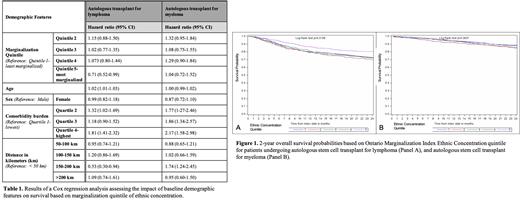Background
Autologous hematopoietic stem cell transplants (ASCT) are potentially life-saving interventions used to treat hematologic disorders. However, it is unclear if socioeconomic disparities impact the patient benefit from ASCT. Recent evidence suggests lower rates of ASCT for patients living in rural settings and for ethnic minority groups. Few population-based studies have assessed comprehensive indices of marginalization as predictors of outcomes after ASCT. In a publicly funded healthcare setting, it is crucial to understand if various aspects of marginalization interact to ultimately impact survival for patients undergoing ASCT.
Methods
We performed a retrospective population-based study using administrative healthcare databases from Ontario, Canada. Patients were included if they had undergone auto-SCT for lymphoma or myeloma between 2010 and 2022. The Ontario Marginalization Index (ON-Marg), created using Canadian census data, explores four key aspects of marginalization: residential instability (referring to housing instability), material deprivation (referring to individual and community abilities to access basic material needs), dependency (referring to lack of income from employment), and ethnic concentration (referring to individuals who are recent immigrants or belonging to a visible minority group). The primary outcome was 2-year overall survival (OS) from time of transplant to death or end of the study period stratified by ON-Marg quintiles. Multivariable Cox regression analyses were used to identify baseline characteristics associated with OS.
Results
A total of 1886 patients underwent ASCT for lymphoma and 2842 patients underwent ASCT for myeloma.
The median age of patients undergoing ASCT for lymphoma was 56 years (IQR 44-63) and 64% of patients were male. 22% of patients had high aggregated diagnosis group (ADG) comorbidity scores and 15% had a prior history of cancer. 2-year OS for patients in the fifth quintile of marginalization of the ethnic concentration index was 80.4% (95% CI 75.9-84.1%), compared to 72.3% (95% CI 67.5-76.5%) in the first quintile ( Figure 1A). This survival advantage (HR 0.71, 95% CI 0.52-0.99) persisted after adjusting for age, comorbidity burden, and distance to hospital ( Table 1). Patients who lived 150-200 km from the transplant center had a lower risk of death compared to patients who lived within 50km of the hospital (HR 0.53, 95% CI 0.30-0.94). 2-year OS was not significantly different for patients in quintile 5 of marginalization of the dependency index compared to quintile 1 (HR 1.25, 95% CI 0.93-1.67), with similarly no significant difference across residential instability or material deprivation.
The median age of patients undergoing ASCT for myeloma was 61 years (IQ 55-66), and 25% of patients had high ADG comorbidity scores. OS was not significantly different across all domains of marginalization, with a 2-year OS of 88.8% (95% CI 85.8-91.2%) in quintile 1 of ethnic deprivation and 87.5% (95% CI 84.7-89.8%) in quintile 5 ( Figure 1B). Higher comorbidity scores were associated with an increased risk of death compared to lower comorbidity scores (HR 2.17, 95% CI 1.58-2.98), as shown in Table 1. Living 150-200 km from the transplant center was associated with worse OS (HR 1.74, 95% CI 1.24-2.45).
Conclusion
This is one of the first studies to examine the effect of marginalization on outcomes after ASCT in a publicly-funded healthcare system. For patients undergoing ASCT for lymphoma, patients in quintile 5 of ethnic concentration had improved 2-year OS compared to patients in quintile 1. One possible explanation is the healthy immigrant effect, whereby immigrant patients are healthier than their Canadian-born counterparts. Cultural factors may also have a protective role. Patients undergoing ASCT for lymphoma who lived farther from the transplant center had a lower risk of death; these patients may be more highly selected based on fitness and disease biology to be referred for transplant compared to patients who live within close proximity. For patients undergoing ASCT for myeloma, 2-year OS was not affected by ethnic concentration quintile. The decision for referral for ASCT for myeloma is not as subjective, with ASCT commonly used in the first-line setting for eligible patients regardless of distance, which likely accounts for this difference. Further work is needed to ensure that all eligible patients receive ASCT.
Disclosures
Prica:Astra-Zeneca: Honoraria; Abbvie: Honoraria; Kite Gilead: Honoraria.


